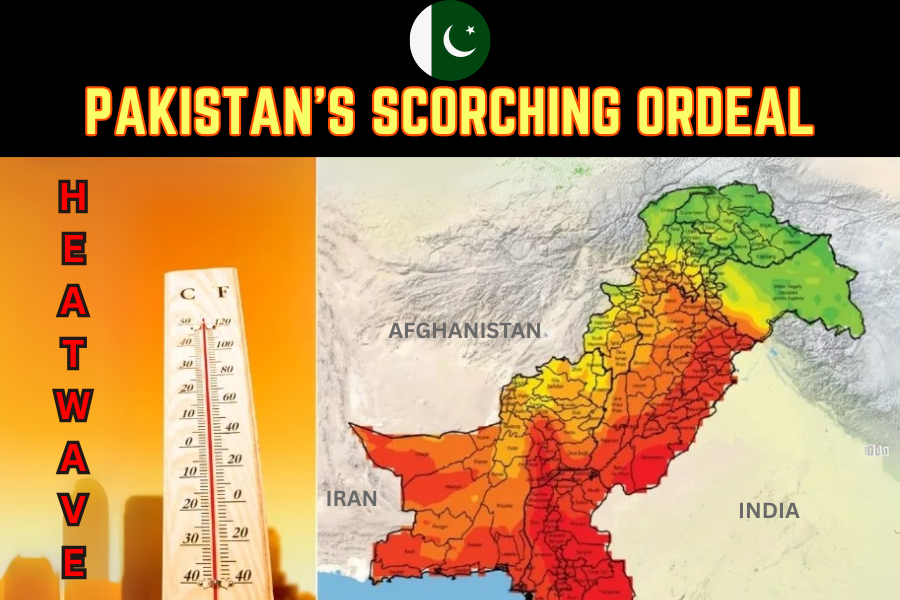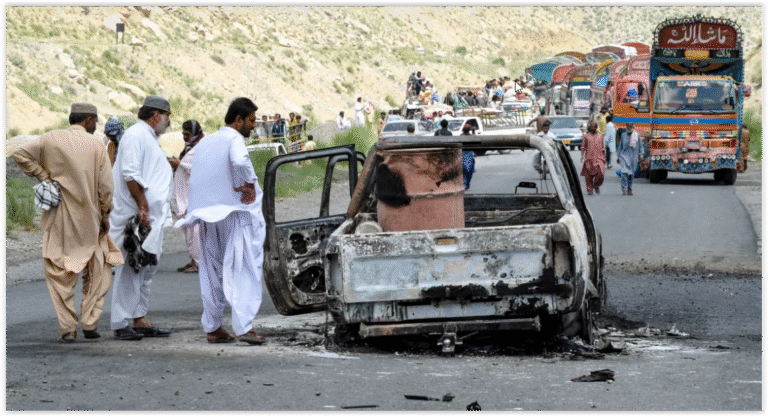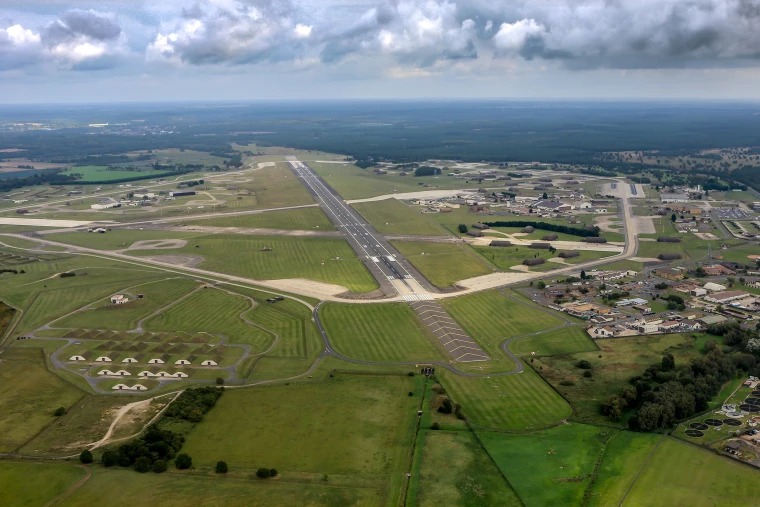(By Khalid Masood)
In the blistering summer of 2025, Pakistan writhes under an unrelenting heatwave, its plains transformed into furnaces where temperatures soar to 50°C. Bhakkar and Jacobabad, scorched at 49°C, stand as grim sentinels of a nation besieged by heat, with hospitals overwhelmed by heatstroke victims and streets deserted under a merciless sun. From Punjab’s sweltering cities to Sindh’s arid heartlands, life grinds to a halt, punctuated by power outages and desperate pleas for hydration. The Pakistan Meteorological Department (PMD) warns of no respite for 48–72 hours, as climate change amplifies a crisis that tests Pakistan’s resilience. This article chronicles the heatwave’s ferocity, its human and economic toll, the government’s response, and the urgent need for climate action in a nation on the frontline of global warming.
A Nation Under Fire: The Heatwave’s Grip
Since early June 2025, a high-pressure system has enveloped Pakistan, driving temperatures 4–7°C above normal across Punjab, Sindh, Khyber Pakhtunkhwa (KP), and Balochistan. Bhakkar in Punjab and Jacobabad in Sindh recorded 49°C, with some areas like Bhakkar hitting 50°C, among the highest in the world this summer. Punjab’s Sargodha (47.8°C), Gujranwala (47.5°C), and Lahore (46.2°C) simmered, while Sindh’s Mohenjo-Daro reached 48°C and Karachi endured 40°C with 70% humidity, rendering conditions unbearable. KP’s Peshawar and Dera Ismail Khan baked at 45–46°C, and Balochistan’s Sibi and Turbat hit 47°C, though Quetta offered mild relief at 38°C. Only Murree’s hill station, at 32°C, provided a fleeting sanctuary. The PMD forecasts persistent heat through June 14, with dust storms and isolated rain in northern KP and Gilgit-Baltistan offering scant relief.
Human Toll: Heatstroke and Desperation
The heatwave’s human cost is staggering, with hospitals across Punjab reporting hundreds of heatstroke cases, particularly among laborers, the elderly, and children. In Lahore, Hyderabad, and Jacobabad, emergency wards are stretched thin, treating patients for dehydration, nausea, and unconsciousness, symptoms of a condition that can kill if untreated. The 2024 heatwave claimed 568 lives in Sindh alone, and 2025’s toll, though unquantified, is rising, with Punjab’s PDMA warning of a “life-threatening situation.” Intermittent power outages, lasting up to 16 hours in Balochistan, disable fans and air conditioners, exacerbating thermal stress. In Lahore, rickshaw driver Muhammad Asif laments, “Even standing in the shade feels like being in an oven,” a sentiment echoed on X, where users decry the absence of cooling centers. Vulnerable groups face the brunt, with UNICEF urging protection for children amid soaring temperatures.
Economic and Environmental Impacts
Pakistan’s economy, heavily reliant on agriculture, reels under the heatwave’s assault. In Punjab and Sindh, wheat and mango yields have plummeted due to high evaporation and stunted growth, echoing 2022’s reduced harvests. The International Rescue Committee warns of food insecurity for 8.6 million across 26 districts, compounded by global commodity price spikes. Livestock losses, numbering 133 in 2024, continue, with rural Sindh reporting dying cattle. Urban commerce falters as markets empty during peak heat, with Karachi’s tea stall owners like Wajid Ali lamenting idle businesses. Power demand for cooling strains Pakistan’s grid, with K-Electric facing criticism for outages. Climate change, driving a fivefold increase in heatwave frequency over three decades, accelerates glacial melt in KP and Gilgit-Baltistan, risking flash floods and water scarcity by 2025.
Government Response: A Race Against Time
The Punjab government, led by Relief Commissioner Nabil Javed, has mobilized to mitigate the crisis. Hospitals have established heatstroke counters, stocked with medicines, while public spaces in Lahore and Multan offer cool drinking water. The PDMA’s helpline (1129) fields emergency calls, and authorities monitor Cholistan’s water supply to avert shortages. Advisories urge citizens to avoid sun exposure from 11 AM to 4 PM, wear loose cotton clothing, and hydrate, with special emphasis on protecting children and the elderly. The National Disaster Management Authority (NDMA) has alerted provincial departments, drawing on lessons from the 2015 Karachi heatwave, which killed 1,200. However, X posts criticize the lack of a cohesive heat action plan, with Punjab’s response deemed reactive. Cooling centers in Lahore and Karachi, while helpful, are insufficient for rural areas, where laborers like Bopal Khan toil under the sun to survive.
Climate Context: A Warning Unheeded
Pakistan’s 2025 heatwave, part of a broader South Asian crisis, underscores its status as the fifth most climate-vulnerable nation, despite contributing less than 1% to global emissions. April 2025 saw Shaheed Benazirabad hit 50°C, 8.5°C above normal, and Balochistan’s 49°C rivaled Death Valley’s extremes. Climate scientists attribute these conditions to human-driven warming, with the World Meteorological Organization noting Turbat’s 53.7°C in 2017 as Asia’s second-highest. Projections warn that by 2050, parts of Pakistan may breach human survivability thresholds, with urban heat islands like Lahore worsening due to concrete sprawl. The 2022 floods, killing 1,739, and 2024’s 2,547 heatstroke cases highlight a pattern of escalating disasters. Dawn’s editorial laments Pakistan’s “woeful unpreparedness,” urging green infrastructure and emission cuts to avert a “new normal” of deadly summers.
Prospects for Relief and Resilience
The PMD predicts the heatwave’s persistence through June 14, with light rain possible in northern KP and Gilgit-Baltistan by Thursday evening, offering marginal relief. Long-term, Pakistan faces a daunting challenge: adapting to intensifying heatwaves while mitigating climate impacts. The NDMA’s 2024 guidelines advocate cooling centers, public awareness, and healthcare upgrades, but implementation lags. Urban greening, as seen in Singapore, could reduce Lahore’s heat island effect, while solar-powered cooling systems might ease grid strain. Globally, stabilizing greenhouse gases is critical, yet Pakistan’s reliance on fossil fuels and limited carbon sinks hampers progress. The 2015 heatwave’s 2,000 deaths prompted emergency measures, but 2025’s crisis demands systemic change—resilient infrastructure, early warning systems, and farmer support—to safeguard 220 million lives.
Conclusion: A Call to Endure and Adapt
As Pakistan swelters under a relentless sun, the 2025 heatwave lays bare a nation at the mercy of climate change. Bhakkar’s 50°C and Lahore’s deserted streets are not anomalies but harbingers of a future where summer is synonymous with survival. The PDMA’s efforts, while vital, are a bandage on a wound deepened by global inaction and local unpreparedness. From laborers fainting in fields to children gasping in hospitals, the human cost demands more than advisories—it requires a reimagining of Pakistan’s cities, farms, and policies. As the world watches, Pakistan’s ordeal is a clarion call: adapt now, or perish in the flames of a warming planet. The choice is ours, and the time is now.







